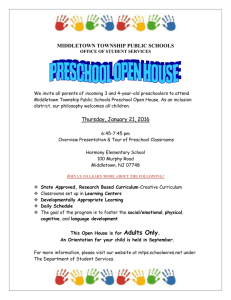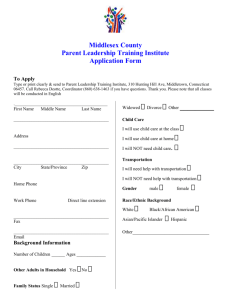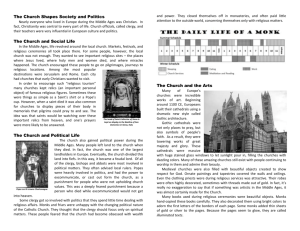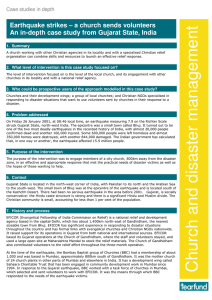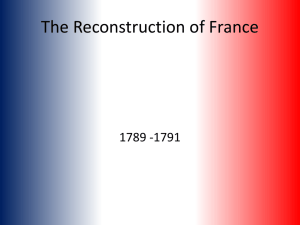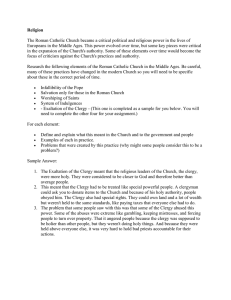A MODEST STUDY OF PERCEIVED ... COMMITMENTS AND VALUES HONORS THESIS BY
advertisement
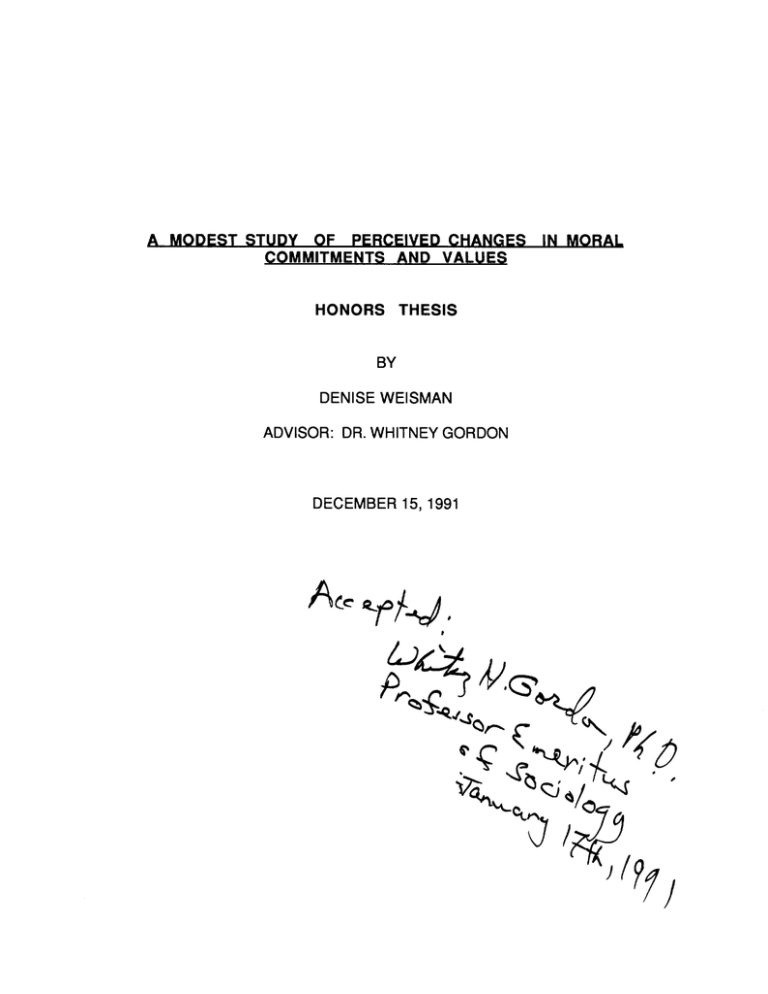
A MODEST STUDY OF PERCEIVED CHANGES COMMITMENTS AND VALUES HONORS THESIS BY DENISE WEISMAN ADVISOR: DR. WHITNEY GORDON DECEMBER 15, 1991 IN MORAL 1».-- \ .::...:) TABLE OF CONTENTS Introduction . 1 Statement of the Problem 2 Literature Review 2 Methods and Sample 8 Findings 11 Discussion 16 Conclusions. 19 Appendix A 22 Appendix B 23 Bibliography. 24 1 A MODEST STUDY OF PERCEIVED CHANGES IN MORAL COMMITMENTS AND VALUES INTRODUCTION College-age persons are faced with many decisions. Whether it is finding a job upon graduation or choosing to question one's value system, these decisions impact not only the individual, but society as well. The consequences of restless probing and criticisms seem to have reached an apogee in America during the late 1960s and early '70s. Many young adults wondered who has the right to say what is right and what is wrong. Today, thoughtful college-age people are engaged, as always, asking: "What is right and what is wrong?" and "How do I decide?" One may be haunted by the thought, "We are about to inherit all of the questions without the answers." Perhaps, they do not even have a foundation on which to base their answers. I decided to probe. I chose not to go to the college students themselves, but rather, to go to a group claiming to represent moral authority, the clergy. I wanted to discern their views of young adults as the latter move into major decision making roles. In essence, my goal was to explore the perceptions of people who are generally seen as moral authorities in regard to continuity and change in the values and moral commitments of college-oriented young adults. Although my main goal was to determine if today's clergy thought college students shared the moral commitments and values which will continue to push America along a generally seen "decent place for all," my findings seemed to take me elsewhere. Most of what I gathered was what college students are thought to have 2 become and what they are facing. Also, I seemed to have encountered the clergy's perceptions of society and their intense feeling that their institution must become more central within the community. My research focused on a select sample of clergy in "Middletown, U.S.A.," i.e., Muncie, Indiana. This study site was most convenient for me and there is considerable research literature for a starting point; materials which date back to the turn of the century. STATEMENT OF THE PROBLEM The essential focus in this study has been to determine what a select sample of the clergy in "Middletown, U.S.A." perceive to be the continuities and changes in the moral commitments and values of college-oriented young adults. LITERATURE REVIEW Numerous sociologists have explored religion within the context of American society. Of particular interest for this study are the works of Robert and Helen Merrell Lynd and of Theodore Caplow. The Lynds studied social trends and transitions within "Middletown." They focused on virtually all aspects of the citizens' lifestyles; I chose to focus on only one -religion and how it relates to moral commitments and values. In their study published in 1929, the prominent religious beliefs of Middletown were: 1. Sufficiency of Christianity as the one true religion. 2. The Bible is sacred. 3 3. God is revealed in Jesus Christ. 4. There is life after death--"heaven" and "hell. " (Lynd and Lynd, 1929, 316-319) The following observations made by the Lynds point out the trends that were evident at the turn of the century, as contrasted to the mood of the mid-1920s: 1. Members of the working class tend to believe their religion more ardently and to accumulate more emotionally charged values that center upon their beliefs. 2. There;s a shift in the status of some religious beliefs over the past generation. Most noted is the decline in the emphasis on heaven and an increased emphasis on hell. This is especially prevalent among the business class. 3. There continues to be a vague belief in God even among those who are lax or doubt their own beliefs. 4. There is an impressively wide range of beliefs. (Lynd and Lynd, 1929,329) Observance of Sunday as the Sabbath was a common practice of Middletown in the 1890s. But, even within this framework of sacred practice, cracks were beginning to surface by the 1920s. Among the activities that began to appeal to citizens of Middletown were: ball games (in city parks), trade union meetings (held on Sunday mornings), golfing at the Country Club, swimming, playing cards, football games, and going to the movies. (Lynd and Lynd, 1929, 339-343) Other interesting aspects at the turn of the century were: 1.) men's views of religion and 2.) the clergyman's role in society's affairs. The men usually accept the religious beliefs of the civilization in which they live, but as one hears their conversation over a period of many months one gets a distinct impression that religion wears a film of unreality to many of them and that its advocates in the pulpit constitute a group apart. (Lynd and Lynd, 1929,339-343) 4 Ministers seem to have had a difficult time feeling comfortable competing with secular agencies for their congregations' attention. This is evidenced in the following quote: Individually the ministers make further efforts to share in the life of the city. Thrust into an undesired aloofness as earthly representatives of an ideal popularly regarded as impossible of achievement by ''poor, weak human nature, " charged with persuading the community to adopt a way of life at variance with its current concerns, they seize upon every opportunity which seems to offer a means of sharing in the life about them without yielding too much of the principles to which they are committed. (Lynd and Lynd, 1929, 354) Also, when ministers were asked, "What do you consider your greatest problem here?" the most consistent answers were "lack of leadership and complacency." (Lynd and Lynd, 1929, 356) Ten years later, in the mid-1930s, in Middletown in Transition the Lynds open their chapter on religion by noting that, s As the gap has widened between that large portion of Middletown religious beliefs which are based upon a body of specific purported historical occurrences and the workaday habits of thought of the city's contemporary secular life, religion has operated increasingly behind a front of symbolic language and ritual. Although there was wide variation from individual to individual, the dominant impression the research staff gained in a year and a half of attendance at Middletown's religious services and of talking with individuals in 1924-25 was that of an unalert acceptance, punctuated periodically in the less socially sophisticated churches by bursts of religious energy during a revival. (Lynd and Lynd, 1937, 295) At this later time (1935) there were new church buildings and new denominations present in Middletown. There seemed to be an increase in women attending services and a decrease in men's presence. Sermons were becoming shorter and the focus of a sermon tended to be more practical. (Lynd and Lynd, 1937, 297) A physiCian said: 5 There is no wave of religious feeling in [Middletown} in the depression, despite the prediction of the ministerial profession that the depression would bring the people closer to God. The churches, although they constantly point to their yearly membership growth, are conscious of the fact that they are slowly slipping. The average [Middletown} citizen has very definite religious beliefs, but for the most part they are a kind of automatic part of the scheme of inherited things and not anything he uses particularly in his daily life. And the depression hasn't changed this. (Lynd and Lynd, 1937,302) It was also apparent to the Lynds that the church was becoming more separated from the life of society. The church was to be concerned only with the "spiritual" needs of people, while society could take care of neediness, lack of food, or homelessness through other organizations. Likewise, the continued secularization of the Sabbath was readily apparent as was an increased separation of church and state. (Lynd and Lynd, 1937, 307) As indirect evidence: The fact appears to be that religion, like education in Middletown, is torn by conflicts as to what its function is and whose values it shall serve, and the depression has aggravated this situation acutely. Its historical loyalty is explicitly defined by its Bible and denominational creeds. Emotionally, this literal loyalty is deeply bitten into the lives of the pews, yet in the operative aspects of living it lives chiefly as a much bandied-about symbol. (Lynd and Lynd, 1937, 309) While, theoretically, the very prevalence of rapid change in Middletown's culture would seem to enhance the potential role of an institution charged with the task of sifting out and identifying the elements of permanence in the current preoccupation with flux, the rigidity of religion in Clinging to its theological verbal stereotypes inherited from an era in the remote past, increasingly unreal to Middletown, tends to introduce barriers to the performance of this very function. The gap between religion's verbalizing and Middletown life has become so wide that the entire institution of religion has tended to be put on the defensive; and the acceptance of a defensive role has tended to mean that it is timid in jeopardizing its foothold in the culture by espousing unpopular causes, when they appear in the economic order, in questions of world peace, and in the elements of contradiction in local institutions. As a result, Middletown's churches appear to be forever bartering the opportunity for leadership in the area of change for the right to continue a 6 shadowy leadership in the Changeless, as the church defines the latter. On almost every issue where controversy waxes hot in Middletown's current world, the local churches take over the causes and symbols of the local business control group. Outstanding, is the almost complete merging of the two areas of religion and patriotism. (Lynd and Lynd, 1937, 311-312) That Christianity is the final form of religion and all other religions are inferior to it. But that what you believe is not so important as the kind of person you are. That nobody would want to live in a community without churches, and everybody should, therefore, support the churches. That churchgoing is sometimes a kind of nuisance, one of the things you do as a duty, but that the habit of churchgoing is a good thing and makes people better. That there isn't much difference any longer between the different Protestant denominations. But that Protestantism is superior to Catholicism. That having a Pope is un-American and a Catholic should not be elected President of the United States. That Jesus is the Son of God and what he said is true for all time. That Jesus was the most perfect man who ever lived. That God exists and runs the universe. That there is a "hereafter." "It is unthinkable that people should just die and that be the end." That God cannot be expected to intercede in the small things of life, but that through faith and prayer one may rely upon His assistance in the most important concerns of life. That preachers are rather impractical people who wouldn't be likely to make really good in business. That I wouldn't want my son to go into the ministry. That Preachers should stick to religion and not try to talk about business, public affairs, and other things "they don't know anything about." (Lynd and Lynd, 1937, 416-417) Theodore Caplow in his more recent study of Middletown entitled All Faithful People (1983), discovered that the Lynds' findings of a decline in religion and religious activities did not occur. Instead, it was found that business and working class Middletowners remai ned relatively active churchgoers and that they seemed to concur on their reasons for attending church. More germane to my study, Middletown's clergy had a more positive and understanding attitude toward youth. 7 The Middletown ministers' optimistic attitudes about the future may reflect an occupational worldview as biased as that held by Middletown preachers described by the Lynds. However, there is other evidence for their faith in the continued vitality of organized religion. In previous chapters, we have reported comparisons between the Lynds' findings and our own that reveal that today's Middletowners are more likely to attend church, to donate larger fractions of their incomes to churches, and to manifest a heightened religious fervency, at least in the business class. The 50-year contrasts seem to show that Middletown people today are more zealous in religious observance than were the townspeople of their grandparents' generation, and yet contemporary Middletown is also much more tolerant of religious and other life-style diversities. (Caplow, 1983, 242) Further: In every measurable way, Middletown's religion has become less puritanical in the past two generations, that is, less conscience striken about faults, less censorious about shortcomings, less emphatic about rewards and punishments, and less preoccupied with sex. The theological implications of these changes are not easy to decipher. It might be argued that the importance of religion has been diminished by the relaxation of the moral criteria that formerly separated saints from sinners. On the other hand, the attitudes toward personal conduct that prevail today in most of Middletown's churches are much more compatible with the doctrine of original sin than the former emphasis on moral perfectability. In the fundamentalist churches, this leads to a view of the world as hopelessly corrupt and unimprovable; the goal of the believer is to stop taking the world seriously. In the mainline denominations, it encourages a type of humility that withholds condemnation of even the most heinous personal acts, with blame reserved for political and economic "systems." (Caplow, 1983,283) In sum, the rich vein of research literature on religion in Middletown suggests that religious commitments are very much present in the city and observances have actually increased in recent decades. Alas, the available literature points only indirectly towards my question concerning the community's able young adults' moral commitments and values as perceived by the local clergy. 8 METHODS AND SAMPLE I started (Fall, 1991) to select this study sample by way of the Yellow Pages of the Muncie telephone book. The complete church listing was used to identify area churches. The list was retyped with addresses and telephone numbers. (This chore helped to eliminate duplication of churches.) In order to obtain a social strata cross-section of the city, a precinct map was used. The churches listed were plotted and marked on the map. Each precinct was assigned a letter (A, ee, GGG, etc.), and each church within a given precinct was assigned a number. Thus, each church was identified by its number and the letter of the precinct in which it was found (A2, Y1, BBB4, etc.). All of the precinct letters were listed on a page with the letter and number of each church behind it. Churches were selected from every other precinct. USing this method eliminated potential bias through knowing which churches would be selected for the study. Eight playing cards (ace, 2,3, 4, 5, 6, 7, 8) were used to select a single church from within each precinct. (No precinct had more than eight churches within it.) Of the selected precincts, churches were randomly chosen, i.e., if a precinct had two churches, two playing cards were used (ace, 2) and one card was taken up. If a precinct had seven churches, seven playing cards were used and one card selected, etc. After a letter-number identification was designated, the church's name was revealed via the corresponding church list. Because of the university and its affiliated religious organizations, any such group or parachurch was excluded in this study ,. 9 sample. (My seemingly contradictory purpose was to obtain the clergy's viewpoints, and because many of these university situated organizations do not have ordained clergy, they were not used. The study was designed to find out what people outside of the university saw as they looked in.) If a chosen letter-number identification corresponded with a "college ministry," the next highest letter-number identification was used. Because some churches appear to have a disproportionately strong role in the community, they were added to the study sample. This decision added a special emphasis on the upper-middle class in the study sample. (See Appendix B for a list of churches interviewed for this study.) A final list was compiled of the churches chosen for the study. Telephone calls were made to each church to set-up interview times with the clergyperson of the church. Every church chosen was contacted at least twice. If a clergyperson did not wish to participate, then the next church for that precinct was chosen (example: Church RR1 does not want to participate. Church RR2 was called.). Three clergypersons declined to participate out of a total of 33. Because of the researcher's own lack of time, only 16 clergypersons were interviewed from within a sample of 33 churches. Although this is a small number, it still remains a representative sample of the chosen population in that the sampling method resulted in a wide variety of clerical and social backgrounds. The survey used was developed by the researcher and consisted of background information and nine discussion questions. The background information consisted of sex, age, denomination, birthplace, description of childhood (family life, 10 mother's and father's roles, community, etc.), whether or not attended college, and finally, the number of years in school, where, and degree(s) earned. Discussion questions focused on today's dominant values in society, values and moral commitments of college-oriented young people, explanations of perceived changes and how the interviewee dealt with the changes, impact of the changes on the congregation and on society, how the congregation deals with changes, what the future holds, and what takes the place of the traditional church in the lives of some Americans. (See Appendix A for a sample of the interview form used.) All of the interviews were conducted in an informal atmosphere. The interviewer met with each clergyperson at his or her church. All interviews were held in the personal office of the interviewee and lasted from 20 minutes to one hour. The characteristics of the sample were as follows: 15 males 1 female 14 Caucasians 2 Afro-Americans Ages ranged from 28 to 65 with the average age being 40.9. Denominations interviewed were: American Baptist Apostolic Pentecostal Baptist Catholics Church of Christ Church of God in Christ Disciples of Christ 1 1 1 1 1 1 1 Nazarene Presbyterian Friends-Quakers Southern Baptist Unitarian Universalist United Methodist 1 1 1 1 1 4 Twelve of those interviewed were the pastor of the congregations (delivers the Sunday sermon). Three were associate pastors and one was a youth pastor. Ten 11 pastors were from the Midwest. Three were from the southern United States, and one was from the Northeast. Of these clergy, three held bachelor degrees only, ten held Masters of Divinity degrees from various institutions throughout the United States. One was currently working on a Master of Divinity, while another was taking graduate courses. Only one held a doctoral degree, and another person was working towards that degree. Family background of the clergy itself ranged from rural to suburban settings; large, extended families to being an only child. Most had small town backgrounds and held traditional, conservative values. Their fathers were the main breadwinners in most of these families, but some mothers were also part of the paid work force. Some adjectives used to describe family life among the clergy were: "pretty sheltered," "lean money," "fabulous," "close-knit," "demanding," "supportive," "selfsufficient," "happy," "wonderful," "loving," and "peaceful." FINDINGS Clearly, the dominant values of college-oriented young adults as seen by the local clergy were individualism, materialism, and consumerism. Most respondents tended to agree that there is a large increase in the focus on "me." When asked, "What changes, if any, do you see in American values/morals when you are dealing with college-oriented young adults?" respondents focused on materialism, relativeness (of everything) versus absolutes, and a lack of moral responsibility. Clergy attributed these perceived shifts to young, educated adults being more conservative and consumer-oriented, changing in attitudes toward sex, 12 unwillingness to make sacrifices, and disregard for consequences of behavior. Other clergy seemed to believe that college-oriented young people have other values than those described above. Several clergy noted a dedication to community causes versus a need simply to be more visible in the community, anxieties about future employment, a concern for humanity, and a growing responsibility for inherited social problems. When asked, "How do you explain these changes?" the clergy's responses varied all the way from access to birth control to the mass media. One clergyperson pointed to the church: "The churches' slowness in change. It is not relevant to society. Apathy is apparent. Values have slowly decayed over time." Four clergypersons pOinted to the mass media and advertising as a reason for all of these changes. One clergyperson even pointed to the "Ronald Reagan generation, a personification of consumerism and conservatism." The fourth question asked, "What impact do these changes have on your congregations and on American society?" Clergy see American society as not engaged in organized religion and "shopping around" for a church. They find their church members less committed: church is second, third, or fourth in their members' lives. Within their congregations, clergypersons deal with more counseling situations, single-parent families, lack of jobs and income, and drugs. Yet one clergyperson saw a broader purview among church members: "My congregation has a social conscience and feels called to be more involved to bring about change." When asked, "How are you dealing with these changes?" clergy responded in many different ways. Some increase their time with God, while others are working to 13 change their own lifestyles. One clergyman has "an unbounding optimism for God to work in all areas of our lives." Another finds himself not understanding situations "until things are out of hand." One clergyman described his experience this way: "Iooking for a house at the lowest possible price we can stand to live in ... investing in education and retirement . .. concerned about quality of our children's education and exposure to negative influences . .. increased anxiety . .. unsure of alternatives. " Another practice seems to be a change in the way sermons are given. Clergy find it hard, as one put it, "[I] try to confront them [congregation] through preaching ... be faithful to the scriptural text and being contemporary, sensitively." Some clergy are also trying to be more open and attentive to the congregations' needs, even during worship services. On a more personal level, clergy cope in varied ways. Some clergy increase their prayers and meditate on God's word. One mentioned crying. On a deeper level, they are trying to understand themselves, their values, and their beliefs in order that they can be more effective in dealing with contemporary issues and trends they see. When asked "How does your congregation deal with these changes?" varied responses were once again received. It is found that many families simply must deal with changes, and they must "stick with" one another. Households continue to struggle with what is seen absolute and what is a matter of opinion. One minister finds his congregation coming to church as a "release and a place to dump anxieties." Some families, as with some churches, are slow to change and are only beginning to see the need for changes. 14 One church's leadership has conducted studies to determine how it can help to meet the community's needs. They want to determine "coming" needs and prepare themselves for the future. They plan to reach out to the community as part of their ministry. One church takes a very fundamentalist, spiritual approach to today's changes: " ... Strengthens our faith . .. hard times strengthen the church and its bond . .. support one another . .. similar problems with similar experiences to share with one another. " Some churches are forming small groups to discuss issues of consumerism and materialism. Others support outside organizations and their goals for change. was told that there is an increasing need to integrate church programs and what the people need. Some church members are renewing themselves through prayer and scripture. Others are overwhelmed by all of the changes, and still others respond aggressively or, on the contrary, "go with the flow." One church was described as "very giving, sacrificial, and learning to be good stewards of what they have." In response to the question, "What do you see for the future?" clergypersons once again responded with various answers, from environmental issues to changes in American health care to a renewal of traditional Judeo-Christian values. Some of these clergy pOinted to a perceived fact that the church is at a turning point or near a crisis. The following quotes illustrate the various opinions: "More environmental issues . .. wrestling with do I just want to make it financially or do I want to make it personally . .. more women will require their husbands to be at home to help . .. moderation of men's and women's roles." 15 "I'm more optimistic . . .ultimately, experimenting with moral values and existential thinking . .. will be required to rethink . .. we'll find ways to come back to absolute values." ''At best, nation will move to German-type health care system. We'll mull around like we are for a while . .. will get worse before they get better . .. confusion . .. eventual crisis . .. precipitous, bad judgement . .. screw around for ten years and then act. " "My pessimistic side--the Amish will be the only Christians left because of no TV and no consumerism . .. My optimistic side--an economic crash in the U.S. which causes al/ of us to reflect on our values on money. " "We're on a kind of a ... turning point/crisis/opportunity. We've pushed materialism about as far as we can go. There is a hunger for some kind of spirituality . .. American says there is no spirituality . . .it's myths . . .only what our five senses can define . .. people will need to rediscover spirituality. " "Hedonism ... America will be hurt economically ... by the end of the decade, political changes will HA VE to be made . .. government will need to step in with severe authority . .. government will reduce all of us. " "I'm optimistic . .. things will be better . .. want to be out of debt . .. double incomes will stay . .. materialism is unimportant . .. people will stand up for the basics. " "We're going into a chaotic period . .. perhaps a fearful, dark period . .. when we realize that our patriarchal way of doing things has led us to a point of no longer working, we will become more distributive, inclusive, and recognize what's wrong with patriarchy. " Although my intentions in this study were to focus on college-oriented young persons, it seemed necessary to ask clergy if they, themselves, had changed as a result of changes around them. All clergy interviewed felt that they had changed. Most find themselves more aware of what is happening. One clergy stated: "1 have increased anxiety about the future. I am more resentful of the action or inaction of state and federal governments. I am also resentful of business. " One clergyman's changes come from "the stage of life I'm in ... still being formulated as to who I am as a pastor." Another tries to listen more and to be more available. 16 Another finds himself caught between the older and the younger generations. One clergy member is becoming "less judgemental and more sensitive to the hurts of a person ... your ministry has to change to meet the needs of the people ... how to minister to abuse or women who have been mollested." One minister is trying to open the eyes of his congregation to the Third World Community by bringing a Burmese student to his home. Another minister is learning to adjust to American culture by learning the balance between work and family life. Yet another finds himself more "bold with the GospeL" Others find themselves increasing their awareness of society's influence in their lives. There is also an overall increased awareness of a broad range of issues and a genuine interest in people and their lives. And the final question, "Does there seem to be anything taking the place of the traditional church in the lives of Americans? If so, what?" Responses were: restaurants; shopping malls; recreation; sports; entertainment; success; materialism; nothing; bar scene; support groups; freedom to do other things; family; TV evangelists-· "electronic churches;" leisure time; consumerism; New Age Movement; media; things-power, money, bodies, possessions; parachurches; hedonism; and pressures of time. DISCUSSION It was interesting to find that many of the churches on the advantaged Northwest side of town had secretaries who were able to make appointments and help with the routine office work. This situation was also found to be true in larger churches in the center of Muncie. On the other hand, many of the churches on the 17 Southside of town had answering machines to receive incoming calls. Also, many of the ministers on the Southside of town had second jobs because they needed the extra income. Many of the findings in this study can be traced back to the Lynds' studies. Their findings of an increase in Sunday activities other than church (Lynd and Lynd, 1929, 339-343) seem still to be prevalent today. There is a wider variety of activities available with some possible hints that these activities may be emerging as the "church" of Americans' lives, a trend already noted earlier in Middletown (Lynd and Lynd, 1929, 339-343), if not by Caplow. The Lynds also noted ministers' unease when trying to fit into the secular society (Lynd and Lynd, 1929, 354). This seems still to be true today. Ministers seem to be learning more about themselves and understanding the areas they must now face, yet when dealing with secular society, they still seem to have a certain unease about what they are about. At the end of their studies in 1935, the Lynds presented a rather gloomy picture of the future of the church. In his study during 1976-1981, Theodore Caplow and his associates found a surprising, positive attitude among Middletown's citizens and the clergy. There seemed to be a consensus about the positive growth of the church and the presence of youth in congregations. In contrast, in this study, clergy appear to have moved away from a sunny prospect. They find today's youth and society more focused on themselves and what they can collect in the way of materialism cum consumerism. There was no overall consensus on the solution to the problem(s) being faced today. Concurrently, many clergypersons believe that there will be some manner of "reawakening" of traditional Judeo-Christian values. Whether this 18 anticipated "reawakening" will be traditional, fundamental Christianity or not remains to be seen. It seems that opinions have changed very quickly over the past ten years. Clergy who were very optimistic in the early 1980s now do not sound so hopeful. Today, optimism is seen in the future, not in the present. The clergy appear to agree that the college student is inheriting many problems, but they also tend to think that the college student is also a source of many problems. Some of the more "liberal" ministers see students as having a great potential to help change this country for the better, but at the same time having to deal with widespread personal anxieties and apathy. In the eyes of Middletown's clergy, the future holds any number of possibilities. Some are preparing for total disaster, while others see disaster on the way, but retain hope that earthly life will be more positive and fulfilling than the gloom that is seen to be looming over them. Most of the clergypersons interviewed are very willing to deal with these changes and to learn to be more helpful to their congregations. There is an underlying tone of wanting to strengthen the church, a "put it back in its rightful place in society." Most clergy would like to see the church become a much more prominent feature in lives of citizens, rather than existing as the third, fourth, or fifth choice of things to do during the week. Many of those interviewed are just now learning to deal with the changes around them, but they seem optimistic about their own potential and are eager to learn, to grow, and to become strong, persistent factors in the lives of the members of their congregations. They want to be known as people who can be counted on in 19 times of need and trouble. CONCLUSIONS This study sample was conducted over a seven week period. Twenty-three churches were randomly selected for interviews. Further, ten churches were selected, as stated earlier, because of their influence as upper-middle class centers. Of these 33 churches, time constraints reduced me to interviews with 16 clergypersons. My original intention was to get a sense for the moral commitments and values of college-oriented and -age young people. My vehicle was a sample of the clergy in the now classic study site of Middletown, U.S.A. To some modest degree I was successful. But along the way, came something else: the discovery of what the clergy see confronting them at the present time. They talked about America's individualism, and its apparent effects on today's church. They, as with an earlier generation of local clergy, also seem to have a difficult time competing with other activities that take people away from church. They offered no magical solutions for solving these problems. Although only 16 clergy were interviewed, the sample remained appropriate for my purposes. Interviews were conducted throughout the city limits. Of the five of the 16 clergypersons interviewed who were not part of the random sampling, because of their denominational affiliations and because of their presumed influence, most of their responses greatly overlapped with the comments made by the randomly selected clergypersons. 20 This study by itself is no way conclusive. The sample was too small to draw any definite conclusions, and only trends and loose conclusions appear warranted. This study could fruitfully be repeated using the same essential methods. Further questions could be considered in addition to the ones used and could deal with men's versus women's involvement in congregations, closer attention to the clergy's view of themselves in today's society, and the actual involvement of college-age and oriented young people in the congregation. Note: one might suspect that many of my interviewees, when speaking, may have slid back and forth between mental images of specific, young adult congregants and much more generalized images of contemporary American society and culture. In overview, what I do conclude on the basis of this study is that: 1. Perceived dominant values in American society, as seen by some clergy in Middletown, U.S.A., are materialism, individualism, and consumerism. 2. Perceived changes in American moral commitments and values among college-oriented young people are reflected in materialism, the development of relative versus absolute values, lack of moral responsibility, and a focus on "me." 3. Explanations for these perceived changes are related to the mass media, the economy, the government, and the church and the family not being able to keep pace with the changes. 4. Of the 16 clergypersons interviewed, all find themselves dealing with social issues that seem to be a part of American life: singleparent families, drugs, counseling situations, lack of jobs, lack of income, busy lifestyles, and juvenile delinquency. 5. Clergypersons were divided: some were optimistic and others pessimistic about the future. 6. The clergypersons interviewed all felt that they had changed because of perceived changes around them. 21 7. Activities the Lynds found in 1929 to be taking the place of the traditional church still seem to be operating in Middletown, U.S.A. today. 8. Caplow and his associates (1983) found a more positive attitude among clergy toward young adults that is not seen in this study. Few of the clergy interviewed mentioned positive attitudes toward college-oriented and -age young adults, but there were several exceptions to this somewhat dour view. 22 APPENDIX A QUESTIONNAIRE BACKGROUND INFORMATION Sex_ __ Age_ _ __ Denomination,_ _ _ __ Discipline _ _ _ _ _ _ __ Birthplace _ _ _ _ _ _ __ What sort of world did you grow up in? College: Y or N Degree,_ _ _ _ _ _ _ _ __ If so, where?_ _ _ _ _ _ _ _ _ __ No. of Yrs. in school_ _ _ _ _ _ __ DISCUSSION 1. What do you take to be the dominant values in American SOCiety? 2. What changes, if any, do you see in American values/morals when you are dealing with college-oriented young people? 3. How do you explain these changes? 4. What impact do these changes have on your congregations and on American SOCiety? 5. How are you dealing with these changes? 6. How is your congregation dealing with them? 7. What do you see for the future? 8. How have you, yourself, changed, (if you have as a result of the changes around you)? 9. Does there seem to be anything taking the place of the traditional church in the lives of Americans? If so, what? 10. [An open-ended, roll-up question] What else do you think I ought to be including in my study? 23 APPENDIX B Churches participating in this study: Christ Temple Church Fairlawn Church of Christ First Church of the Nazarene Gethsemane United Methodist Church Hazlewood Christian Church Industry United Methodist Church Old Town Hill Baptist Church Riverside Avenue Baptist Church Terrestrial Temple Trinity Baptist Church Unitarian Universalist Church Churches selected because of their presumed influence in the community: College Avenue United Methodist Church First Presbyterian Church Friends Memorial Church High Street United Methodist Church Saint Mary's Catholic Church 24 BIBLIOGRAPHY Cited: Caplow, T., et.al. (1983). All Faithful People: Change and Continuity in Middletown's Religion. Minneapolis: University of Minnesota Press. Lynd, R.S. and Lynd, H.M. (1929). Middletown: A Study in American Culture. New York: Harcourt, Brace, and Company. Lynd, R.S. and Lynd, H.M. (1937). Middletown In Transition: A Study in Cultural Conflicts. New York: Harcourt, Brace, and Company. General: Bellah, R.N., et.al. (1985). Habits of the Heart: Individualism and Commitment in American Ufe. Los Angeles: University of California Press. Caplow, T. (1991). American Social Trends. San Diego: Harcourt Brace Jovanovich, Publishers. Glock, C.Y. and Bellah, R.N. (Eds.). (1976). The New Religious Consciousness. Los Angeles: University of California Press. Kornblum, W. (1988). Sociology: In a Changing World. Chicago: Holt, Rinehart, and Winston, Inc. Lacey, M.J. (Ed.). (1989). Religion and Twentieth-Century American Intellectual .I...im.. New York: Cambridge University Press. Ritzer, G., Lammeyer, K.C.W., and Yetman, N.R. (1979). Sociology: ExperienCing a Changing SOciety. Boston: Allyn and Bacon, Inc. VanAllen, R., et.al. (Eds.). (1978). American Religioys Values and the Futyre of America. Philadelphia: Fortress Press.
